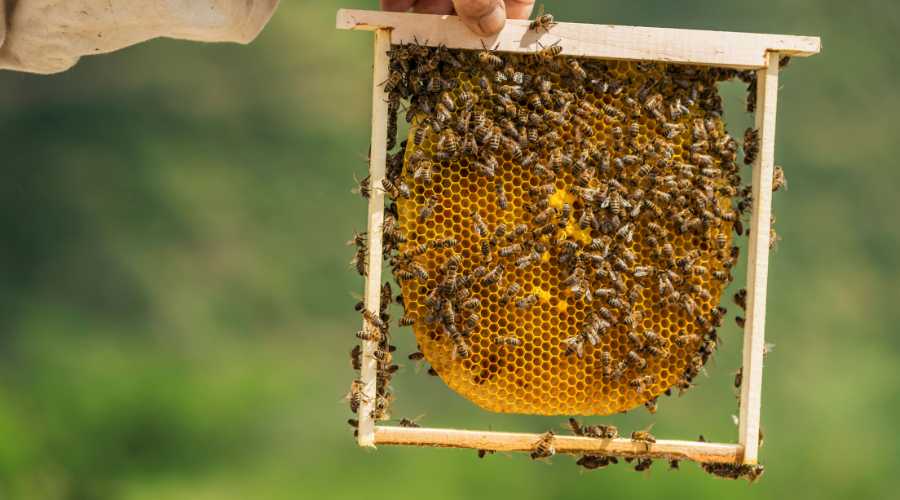Beekeeping or apiculture offers numerous benefits for both the environment and those who practice it.
As a beekeeper, you contribute to pollination and biodiversity, produce honey and other bee products, and generate income.
However, starting a beekeeping business requires proper planning and preparation to ensure success.
In this guide, we’ll walk you through the steps to start your own beekeeping business, from understanding the basics to marketing and selling your products.
Getting Started: Research and Planning
Understanding the basics of beekeeping
Types of bees and their roles
Honeybees are social insects that live in colonies consisting of three types of bees: queens, workers, and drones. The queen is the only fertile female, laying eggs and maintaining the colony’s population. Worker bees, which are infertile females, forage for nectar and pollen, care for the brood, and perform various tasks in the hive. Drones are male bees with the sole purpose of mating with the queen.
Hive management
Hive management involves ensuring the health and productivity of your bees. This includes inspecting hives regularly, providing adequate space, controlling pests and diseases, and ensuring proper ventilation.
Beekeeping equipment
Essential beekeeping equipment includes hives, frames, a smoker, a hive tool, a bee brush, and protective gear such as a veil, gloves, and a bee suit.
Legal requirements and regulations
Local and national regulations
Familiarize yourself with local and national regulations related to beekeeping, such as zoning ordinances, hive placement, and colony registration requirements.
Licensing and permits
Depending on your location, you may need to obtain a license or permit to operate a beekeeping business. Check with your local government or agricultural extension office for specific requirements.
Insurance considerations
Consider purchasing liability insurance to protect yourself and your business from potential losses or damages resulting from beekeeping activities.
Assessing your location and environment
Climate and weather factors
Bees thrive in a variety of climates, but extreme temperatures and weather conditions can impact their productivity and health. Ensure your location provides a suitable environment for bees to forage, reproduce, and overwinter.
Availability of forage for bees
Bees need a diverse range of nectar and pollen sources for optimal health. Ensure your apiary is close to flowering plants throughout the seasons to support your bees’ nutritional needs.
Proximity to other apiaries or farms
Nearby apiaries or farms may offer opportunities for collaboration or competition. Understanding the local beekeeping landscape can inform your business strategy and hive management practices.
Developing a business plan
Financial projections
Create a detailed financial plan, including startup costs, ongoing expenses, and projected revenues. This will help you determine the feasibility of your beekeeping business and identify potential financing sources.
Marketing and sales strategies
Develop a marketing plan to reach your target audience, including branding, pricing, and promotional activities. Consider how you’ll sell your products, such as through farmers’ markets, specialty food stores, or online platforms.
Operational plans
Outline your day-to-day operations, including hive management, product processing, and customer service. Establish routines and procedures to streamline your business and maximize efficiency.
Setting Up Your Apiary
Choosing the right site
Accessibility and security
Select a site that is easily accessible for hive maintenance and product harvesting. Ensure the area is secure from theft, vandalism, and predators like bears.
Sunlight and wind exposure
Choose a location with adequate sunlight, ideally with morning sun exposure to encourage bee activity. Ensure the site is protected from strong winds, which can damage hives and affect bee flight.
Space for hive expansion
Consider the potential for growth when selecting a site. Allocate enough space for additional hives as your colony numbers increase or as you expand your business.
Selecting and sourcing bees
Purchasing bees or catching a swarm
You can start your apiary by purchasing packaged bees, nucleus colonies, or complete hives from reputable suppliers. Alternatively, you may catch a swarm or obtain a colony from an experienced beekeeper.
Selecting bee strains suited to your region
Different bee strains exhibit varying traits, such as disease resistance, temperament, and honey production. Choose a strain suitable for your climate and management goals.
Assembling and maintaining your equipment
Hives and hive components
Assemble and prepare your hives, including hive bodies, frames, and foundation. Paint the exterior of the hive with non-toxic paint to protect the wood from weathering.
Protective gear and tools
Purchase and maintain protective gear, such as a bee suit, gloves, and a veil. Gather essential tools like a smoker, hive tool, and bee brush to assist with hive inspections and management.
Harvesting and processing equipment
Acquire equipment for honey extraction, such as an extractor, uncapping knife, and strainer. If producing beeswax or other products, gather the necessary tools and supplies for processing.
Managing Your Apiary
Regular hive inspections
Monitoring for pests and diseases
Inspect your hives regularly to identify and address potential issues, such as pests, diseases, or hive damage. Prompt intervention can prevent more significant problems and colony loss.
Assessing honey production
Monitor honey stores during inspections to determine when to add additional supers or harvest honey. Ensure your bees have enough honey reserves to sustain them through the winter.
Ensuring proper hive maintenance
Address any hive maintenance issues during inspections, such as repairing damaged components or cleaning debris from the bottom board.
Seasonal beekeeping tasks
Spring preparations and swarm management
Prepare your hives for spring by cleaning and repairing equipment, assessing winter losses, and replacing dead colonies. Monitor for swarming behavior and take steps to prevent or manage swarms.
Summer honey harvesting
Harvest honey during the summer months when nectar flows are abundant. Extract and process honey promptly to maintain freshness and quality.
Fall and winter hive maintenance
Prepare your hives for the colder months by consolidating honey stores, reducing hive entrances, and providing insulation or wind protection as needed.
Bee health management
Integrated pest management
Implement integrated pest management strategies to control pests such as Varroa mites and wax moths. This may include chemical, biological, or mechanical control methods.
Disease prevention and treatment
Monitor your colonies for signs of diseases, such as American foulbrood or Nosema, and take appropriate action to prevent or treat these conditions.
Marketing and Selling Your Bee Products
Identifying your target market
Local farmers’ markets
Farmers’ markets provide an excellent opportunity to sell your products directly to consumers and build relationships within the community.
Specialty food stores
Partner with local specialty food stores to stock your products, reaching customers who value high-quality, locally-produced goods.
Online sales platforms
Create an online presence through a website or e-commerce platform, expanding your market reach and allowing for direct sales to customers.
Promoting your bee products
Branding and packaging
Develop attractive branding and packaging for your products, showcasing their quality and uniqueness. Effective branding can help your products stand out in a competitive market.
Social media marketing
Utilize social media platforms to promote your products, share engaging content, and connect with potential customers. Consistent and targeted social media efforts can help grow your customer base.
Networking within the beekeeping community
Join local and national beekeeping organizations to network with other beekeepers and industry professionals. Engaging in the beekeeping community can provide valuable insights, resources, and potential collaborations.
Expanding your product line
Beeswax products
Diversify your offerings by producing beeswax products, such as candles, lip balms, or skincare items. These products can appeal to a broader range of customers and increase your revenue potential.
Pollination services
Offer pollination services to local farmers and orchard owners, providing an additional income source and promoting the importance of honeybees in agriculture.
Beekeeping workshops and education
Share your knowledge and passion for beekeeping by offering workshops, classes, or educational materials. This can help establish your reputation as an expert and create additional revenue streams.
Conclusion
Beekeeping is a rewarding endeavor with numerous benefits, both environmental and financial.








